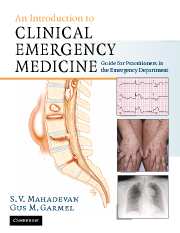Book contents
- Frontmatter
- Contents
- List of contributors
- Foreword
- Acknowledgments
- Dedication
- Section 1 Principles of Emergency Medicine
- 1 Approach to the emergency patient
- 2 Airway management
- 3 Cardiopulmonary and cerebral resuscitation
- 4 Cardiac dysrhythmias
- 5 Shock
- 6 Traumatic injuries
- 7 Prehospital care and emergency medical services
- 8 Pain management
- Section 2 Primary Complaints
- Section 3 Unique Issues in Emergency Medicine
- Section 4 Appendices
- Index
6 - Traumatic injuries
Published online by Cambridge University Press: 27 October 2009
- Frontmatter
- Contents
- List of contributors
- Foreword
- Acknowledgments
- Dedication
- Section 1 Principles of Emergency Medicine
- 1 Approach to the emergency patient
- 2 Airway management
- 3 Cardiopulmonary and cerebral resuscitation
- 4 Cardiac dysrhythmias
- 5 Shock
- 6 Traumatic injuries
- 7 Prehospital care and emergency medical services
- 8 Pain management
- Section 2 Primary Complaints
- Section 3 Unique Issues in Emergency Medicine
- Section 4 Appendices
- Index
Summary
Scope of the problem
Traumatic injuries account for about 37% of emergency department (ED) visits. In 2000, EDs in the US evaluated and treated more than 29.5 million people for injuries. More than 148,000 of these people died as a result of traumatic injuries. Of these deaths, 43,354 were the result of motor vehicle crashes, 16,765 from homicide, and 13,322 from falls. Each year, approximately 7000 fatalities occur in pedestrians struck by automobiles. Falls are the number one cause of non-fatal trauma and the second leading cause of brain injury. According to a 1999 study (using 1993 data), the treatment and long-term care of injuries cost $69 billion, approximately 12% of medical care expenditures.
Patients with severe or life-threatening traumatic injuries may present to the ED at any time of day, either immediately following their injury or in a delayed fashion. They may arrive by ambulance having benefited from pre-hospital care and advanced notification, or be “dropped off” by a friend or family member. Emergency physicians must be skilled at the initial evaluation and treatment of these patients.
Peaks of death
Death from traumatic injury tends to occur during one of three distinct time frames following the injury. The first “peak of death” occurs within seconds to minutes of the injury, typically resulting from devastating injuries to the central nervous system, heart, or major vessels. Very few of these patients can be saved.
The second “peak of death” occurs minutes to hours following the injury.
- Type
- Chapter
- Information
- An Introduction to Clinical Emergency MedicineGuide for Practitioners in the Emergency Department, pp. 93 - 116Publisher: Cambridge University PressPrint publication year: 2005



